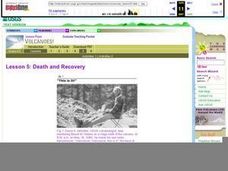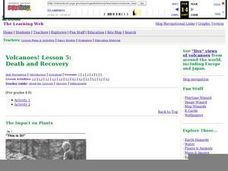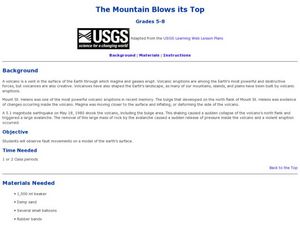Curated OER
Avalanche!
Students build a model representing a snow-covered mountain out of flour, sugar, and potato flakes. Then they use the model to recreate an avalanche.
Curated OER
Avalanche
Students investigate natural disasters by participating in an experiment. In this water formation lesson plan, students define the dangers associated with avalanches and landslides. Students utilize a bag of sand, meter-stick and a wood...
Curated OER
Science: Avalanche!
Eighth graders examine avalanches after reading excerpts from John Muir's book, "The Yosemite." In small groups, they conduct experiments with flour, sugar, and potato flakes representing different snow consistencies. Then, 8th graders...
Curated OER
Forecasting the Path of Mudflows
Students watch a demonstration to introduce them to the consistency of mudflows and how they move. In groups, they compare and contrast volcanic avalanches and mudflows. They create their own model of a volcano, simulate how it erupts...
Curated OER
Avalanche!
Students explain that when forces on an object are balanced, the motion of object does not change. They describe how an object changes its motion when forces on it are unbalanced. They plan and conduct a scientific investigation to test...
Curated OER
Fire, Rock and Water Volcanoes!
Students participate in a demonstration that helps them visualize mudflows and how they move. In this exploratory lesson students simulate a mudflow and create an avalanche.
Curated OER
Volcanoes!: The Mountain Blows its Top
Learners observe two demonstrations to conclude why bulge developed on the north flank of Mount St. Helens and conclude that when the "cap" was removed the pressure inside the volcano was suddenly released causing the violent eruption.
Curated OER
Death and Recovery
Mount St. Helens erupted on May 18, 1980, devastating plant and animal life for miles around. Two activities are included in this lesson plan. In one, learners evaluate tree rings to determine the age of a tree and the year of a volcano....
Curated OER
Volcanoes!: Forecasting the Path of Mudflows
Learners construct a mockup of a volcano by crumbling up newspapers and piling them into the shape of a volcano. They place a tarp over the newspapers making sure the tarp is large enough to simulate a flat area at the volcano's base....
Curated OER
Slip Slidin' Away
Students investigate mechanical weathering as a form of erosion. In this erosion lesson, students, define weathering and erosion before determining how the Earth's surface is in a constant state of change. They watch a video, access...
Curated OER
There's a Volcano in my Backyard!
Learners utilizing a volcanic hazard map of Mount Rainier, reach conclusions about the potential hazards of future eruptions. They create educational materials about these hazards and what to do if one erupts again in the future.
Curated OER
Volcanoes: Death and Recovery
Students examine the aftermath of a volcano. In groups, they participate in activities focusing on the impact on plants and animals. To end the lesson, they discuss the positives to the environment after a volcanic eruption.
Curated OER
Shake, Rattle, and Roll: Mt. St. Helens - Lesson Plan 2
Students compile information on volcanic activity at Mount St. Helens. In this earth science lesson, students use the information they gathered on Mount St. Helens to answer questions and create charts in Excel. Then students...
Curated OER
The Earth Around Us: Air, Water & Soil
Second graders explore erosion and find the factors effecting erosion of hillsides. In this erosion lesson, 2nd graders experiment by creating a hillside and simulating rain. Students discuss and record their results on...
Curated OER
The Mountain Blows its Top
Young scholars replicate a volcanic eruption. In this volcanoes lesson, students follow the provided procedures to show and describe how the inflation of a bulge led to the eruption of Mount St. Helens.
Curated OER
All About Me
Students are introduced to the characteristics of an autobiography. After reading excerpts from "The Diary of Anne Frank", they discuss how two people can see the same event in different ways and write about the event in the journals...
















